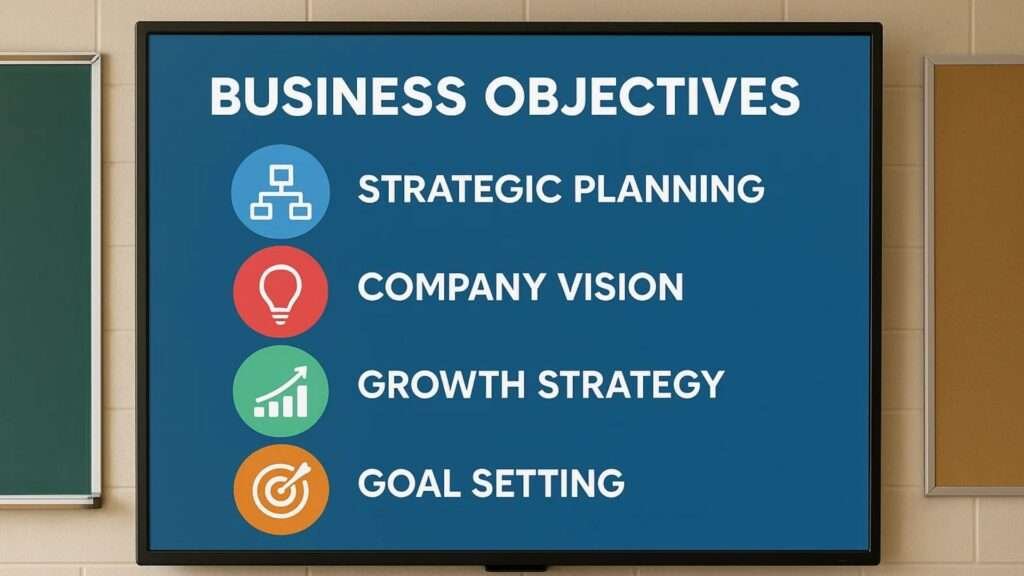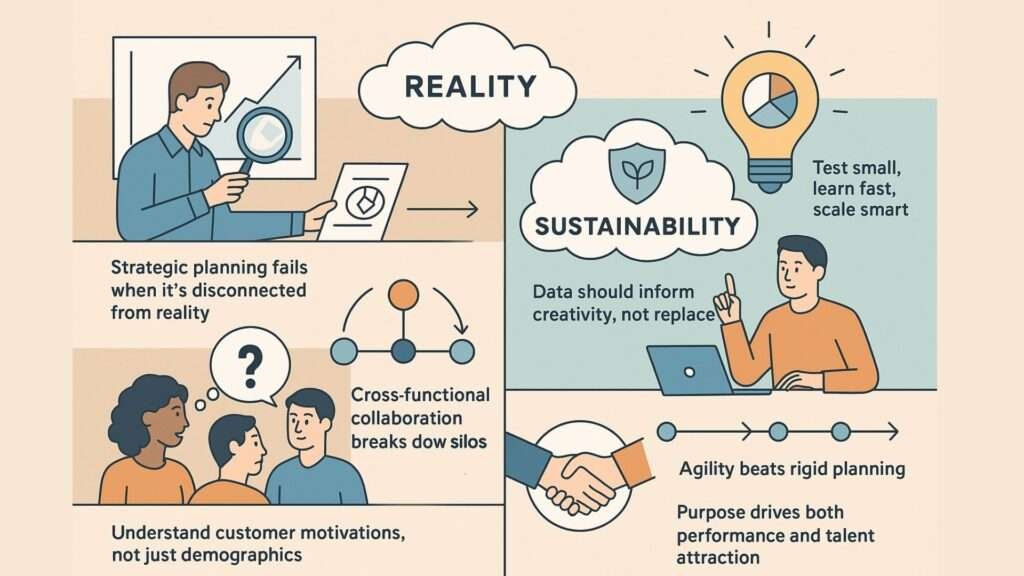
Defining Your Business Goals
For a new business, investing time, money, and energy into comprehensively defining business goals is a foundational step that sets the trajectory for success. Clear goals provide direction, align resources, and establish measurable outcomes, ensuring that every decision contributes to the overarching vision.
Without well-defined objectives, a startup risks mis-allocating resources, pursuing misaligned opportunities, or losing focus amidst the chaos of launching a venture.
Actionable Steps for New Businesses:
Identify Your Core Objectives:
Define your target market, set specific revenue targets, and outline concrete growth milestones.
Document and Prioritize:
Create a written plan that lists your objectives and ranks them by importance, ensuring that every goal is actionable and measurable.
Align Teams and Resources:
Clearly communicate these objectives to your team so every member understands their role in achieving the shared vision.
Integrate with Operational Planning:
Translate your business goals into departmental strategies such as marketing, hiring, and financial planning.
Establish Metrics and Reviews:
Implement key performance indicators (KPIs) to track progress and schedule regular reviews to ensure alignment with evolving business needs.
For businesses operating for several years, revisiting and potentially redefining goals is equally critical. As markets evolve, customer preferences shift, and competitive landscapes change, starting with periodic reassessments of your objectives ensures that your company remains agile and responsive.
Internal factors such as changes in personnel or operational capacity can also influence your ability to execute the original plan. Rather than clinging to outdated goals, your businesses must adapt, whether that means pivoting to new offerings or re-prioritizing internal initiatives.
Actionable Steps for Established Businesses:
Conduct a Strategic Audit:
Regularly review your current objectives in the context of market trends and internal performance.
Engage with Key Stakeholders:
Solicit feedback from employees, management, and partners to determine if current goals align with operational realities.
Reassess and Revise:
Update your objectives based on both internal capabilities and external market dynamics, ensuring they remain relevant and ambitious.
Realign Resource Allocation:
Adjust budgets, staffing, and other resources to support revised goals effectively.
Implement a Continuous Improvement Process:
Establish a framework for regular check-ins and updates, allowing for flexibility and accountability as business circumstances shift.
Financial growth, a common aspiration for most businesses, hinges on strategic clarity. Whether it’s a startup setting out to achieve a specific sales volume within its first year or an established company confronting a plateau in revenue, clearly defined goals offer a framework for effective decision-making. These objectives guide where to invest, whether it needs to be in marketing, technology, workforce expansion, or new market ventures, making sure every dollar spent is aligned with long-term success.
Actionable Steps to Drive Financial Growth:
Set Revenue and Profitability Benchmarks:
Define short- and long-term financial goals that are both realistic and challenging.
Prioritize Investments:
Allocate resources by evaluating the potential return on investment (ROI) of initiatives that align with your key objectives.
Integrate Financial Reviews:
Align your financial planning with your strategic reviews, ensuring that budgetary decisions support growth and adaptability.
Plan for Contingencies:
Incorporate risk management strategies, such as maintaining cash reserves or diversifying revenue streams, into your financial goals.
The process of defining or revisiting goals not only provides a roadmap for growth but also fosters resilience. Anticipating challenges—whether from economic downturns, supply chain disruptions, or market shifts—allows businesses to build robust contingency plans. By proactively planning for unexpected events, businesses can mitigate risks and respond swiftly to changing circumstances. Engaging stakeholders in these planning sessions cultivates a culture of shared responsibility, boosting morale and ensuring that every team member is committed to overcoming obstacles.
Actionable Steps to Enhance Resilience:
Anticipate Potential Challenges:
Develop a risk assessment matrix that outlines possible economic, operational, and competitive threats.
Incorporate Contingency Plans:
Set aside resources specifically for managing unforeseen setbacks, such as establishing a cash reserve.
Facilitate Open Communication:
Regularly update the team on potential risks and the strategies in place to address them.
Review and Update:
Establish a cycle of continuous review to refine your contingency measures as conditions change.
In a nutshell, whether you are launching a new venture or steering an established enterprise, dedicating resources to defining and periodically rethinking business goals is indispensable.
This proactive approach ensures strategic alignment, drives financial growth, and equips businesses to navigate change effectively, ultimately paving the way for sustained success.
Business Objectives

Clear: For Strategic Growth And Competitive Advantage.
Actionable: For Data-Driven Decision Making.
Customer-Focused: For Enhanced Market Penetration.
Comprehensive: For Sustainable Organizational Success.
Innovative: For Driving Team Performance.
Robust: For Achieving Measurable Financial Milestones.
Strategic: For Accelerating Revenue Growth.
Integrated: For Cross-Departmental Alignment.
Transparent: For Building Stakeholder Confidence.
Dynamic: For Adapting To Market Trends.
Purposeful: For Aligning Company Vision And Strategy.
Evaluation-Oriented: For Continuous Operational Improvement.
Scalable: For Long-Term Enterprise Expansion.
Metrics-Driven: For Optimizing Performance Outcomes.
Future-Focused: For Proactive Risk Mitigation.
Strategic Planning.

1. Strategic planning fails when it’s disconnected from reality: A lot of plans look great on paper but fall apart because they’re created in isolation from actual business challenges and market conditions.
2. Sustainability means building resilience, not just being eco-friendly: True business sustainability is about creating systems that can weather storms, adapt to change, and grow without depleting resources or burning out teams.
3. Data should inform creativity, not replace it: Use analytics to give your creative ideas the best chance of success by grounding them in customer behavior and market reality, rather than making decisions based on gut feelings.
4. Test small, learn fast, scale smart: Instead of launching big campaigns and hoping they work, start with smaller tests, measure results, and iterate based on what actually performs.
5. Cross-functional collaboration breaks down silos: Success happens when marketing, sales, product, and other departments work toward shared outcomes rather than competing departmental goals.
6. Understand customer motivations, not just demographics: Knowing someone is a “millennial in an urban area” is less valuable than understanding the specific problems they’re trying to solve.
7. Agility beats rigid planning: Companies that can adapt quickly to changing circumstances outperform those with detailed but inflexible long-term plans.
8. Purpose drives both performance and talent attraction: Strong values and meaningful missions create emotional connections with customers and attract employees who bring more creativity and commitment.
9. Look for opportunities others miss: Success often comes from understanding what customers actually want rather than just copying what competitors are doing.
10. Align everyone around shared outcomes: When all departments focus on customer success and business growth instead of their own metrics, execution becomes much more effective.
11. Build capabilities, not just predictions: Instead of trying to predict the future, develop organizational abilities that help you respond effectively to whatever comes next.
12. Measure what predicts long-term success: Track brand trust, employee engagement, and customer satisfaction alongside financial metrics, as these often predict future financial performance.
13. Integration beats isolation: The most successful strategies treat sustainability, data, agility, and purpose as interconnected parts of how you run your business, not separate initiatives.
14. Speed of decision-making is a competitive advantage: Companies that can make good decisions quickly, especially during uncertainty, often outperform those with slower, more bureaucratic processes.
15. The goal is building adaptive capacity, not perfect prediction: Strategic planning should create a business that can thrive regardless of what the future brings, rather than trying to predict and plan for every possible scenario.
Strategic Planning: A Real-World Guide.

Strategic planning often feels like a dusty academic
exercise, executives locking themselves in a room, churn out buzzword-laden presentations,
and six months later wonder why nothing improved.
In contrast, I feel that the best plans are living
frameworks: grounded in reality, flexible enough to evolve, and designed to
drive meaningful growth in the messy, fast-moving world we actually work in.
Why Some Strategic
Plans Can Fail.
Plans fall apart when they’re created in isolation.
Common pitfalls include:
- Ignoring
real business challenges and market shifts.
- Overreliance
on gut instinct instead of hard data.
- Siloed
departments pursuing conflicting goals.
- Rigid
timelines that can’t adapt when conditions change.
Avoid these traps by embedding feedback loops,
cross-functional input and regular reality checks into every stage of planning.
Sustainability as
Resilience.
True sustainability isn’t just about “being green.”
It’s about building systems that can:
- Weather
economic downturns.
- Adapt
to new technologies and customer behaviors.
- Grow
without exhausting resources or burning out your team.
Patagonia exemplifies this: environmental stewardship
is woven into product design, supply-chain decisions and marketing, creating
loyalty that’s almost impossible for competitors to replicate.
Data-Informed
Creativity.
Analytics shouldn’t replace creativity; they should
power it. A practical approach involves:
1.
Identifying key metrics (engagement rates, conversion
paths, churn drivers).
2.
Hypothesize creative concepts based on data patterns.
3.
Test variations in small batches.
4.
Scale the winners, refine or kill the rest.
Dollar Shave Club rose to fame by obsessively testing
video styles, price points and messaging, letting real performance data guide
their creative bets.
Agile Experimentation.
Instead of big-bang launches, adopt “test small, learn
fast, scale smart”:
- Run
micro-campaigns on social channels.
- Measure
engagement, click-throughs, and conversion in real time.
- Pivot
or double down within days, not months.
This approach mirrors software sprints and keeps you
ahead when markets pivot overnight.
Cross-Functional
Teams Break Silos.
Aligning marketing, sales, product, and finance
unlocks speed and innovation:
- Shared
dashboards track common KPIs.
- Joint
sprint reviews ensure rapid course corrections.
- Multidisciplinary
squads tackle customer pain points end to end.
Airbnb’s pandemic pivot, to longer-stay packages and
virtual experiences, owed everything to this integrated teamwork.
Customer-Centric
Insights.
Go beyond demographics. Map real motivations:
- What
problems is your audience desperate to solve?
- Which workarounds
are they already using?
- What
emotional triggers drive their choices?
Netflix disrupted Blockbuster by zeroing in on
convenience and variety; then leapt ahead by delivering originals when
customers craved fresh stories.
Organizational
Alignment.
When every team focuses on customer success and
sustainable growth:
- Creative
briefs tie directly to revenue or satisfaction goals.
- Data
insights inform product roadmaps.
- Sales
feedback shapes marketing experiments.
This unified focus turns plans on paper into outcomes
in the market.
Building Adaptive
Capabilities.
The goal isn’t perfect prediction, it’s adaptive
capacity. Look closely at:
- Flexible
budgeting that reallocates funds on the fly.
- Continuous
learning programs for your people.
- Scenario
planning, not single-track forecasting.
Leadership with
Purpose.
Profit and purpose aren’t mutually exclusive. A strong
mission:
- Sparks
emotional connections with customers.
- Attracts
talent energized by your cause.
- Drives
innovation rooted in genuine values.
Integration Over
Isolation.
Stop treating sustainability, data, agility, and
purpose as separate silos. View them as interconnected gears in a single
engine.
Let data guide your creative sprints, let purpose
infuse every metric, and let agility ensure you can pivot when the unexpected
arrives.
The Next Steps.
Review your next quarterly plan. For each initiative,
ask:
- Is it
grounded in real data or market feedback?
- Does it
build resilience and adaptive capacity?
- Does it
tie back to a shared purpose and customer success?
Then, Lastly:
Highlight any gaps, realign with these principles, and
turn your strategic plan into a living roadmap for sustainable growth.

